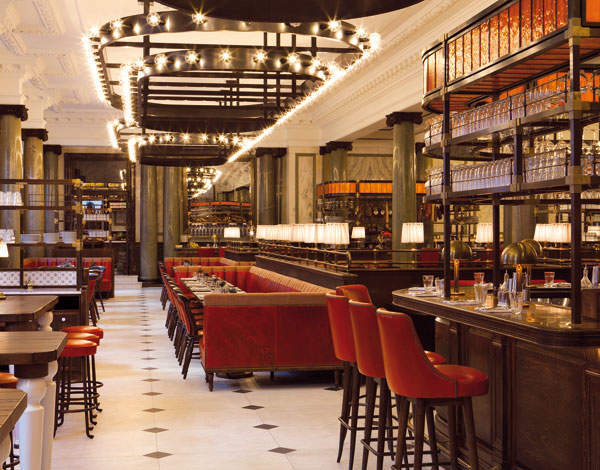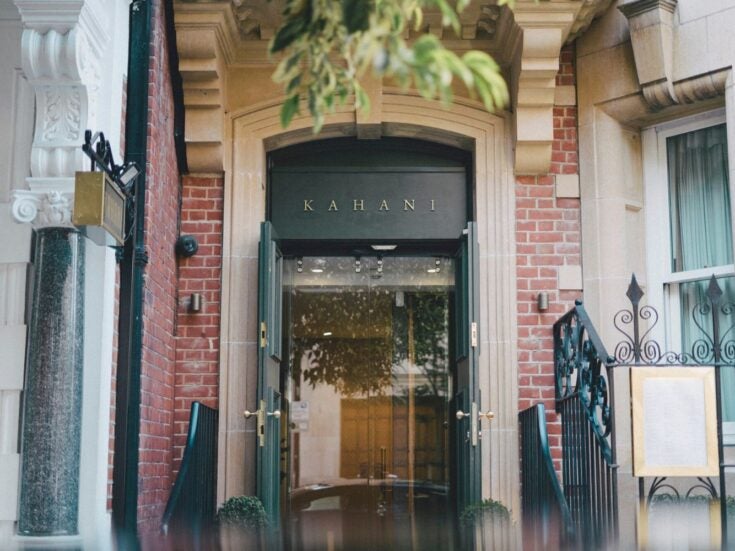

FRONT RUNNER
He is one of the consistent ingredients that has helped to flavour the London restaurant scene over the past three decades. He is often dressed in one of his many dazzling three-piece suits — be they outlandishly, garishly checked with lemon, lime green and pink or just plain bright blue — there is always a slightly crazed, gappy-toothed smile, there’s a bald head and there are his glasses.
In fact, you would recognise him just from his glasses: round, John Lennon-style (although Lennon probably pinched the idea from him). And then there’s his slightly mumbling voice, with an untraceable accent and plenty of energy: big, enthusiastic, welcoming. For this is the Spitz — Jon Spiteri, one of London’s most distinctive maître d’s. And unlike any other, he doesn’t seem to belong to one particular restaurant; rather they come to him.
Jesus Adorno is for ever wedded to Le Caprice; likewise the name of Fernando Peire is synonymous with the Ivy. Silvano Giraldin was always and only the maître d’ of Le Gavroche. But the Spitz flits. He’s too restless. Indeed, he is as eager to walk the floor with you and waltz you to your table — as he so elegantly did for me recently at the Holborn Dining Room — as he is to pop up front of house at the latest trendy London restaurant.
This perhaps explains why his CV reads like a list of the top ten restaurants of London. You’ll run out of fingers naming the places where he has been the main man at the door, but wherever he is he lends the place pizzazz. It may be new, but if Jon Spiteri is there it’ll feel familiar.
Which is why the Spitz is currently at the Holborn Dining Room in the Rosewood Hotel (pictured below), run by Des McDonald, that gangster-looking restaurateur (you know: stubble, long black tie, Jason Statham-type thing) who was formerly CEO of Caprice Holdings and one-time head chef of the Ivy. The Spitz could hang in at the Holborn Dining Room for some time, but on his past form I’d give him two to two-and-a-half years. But he is an extraordinary asset to such a place, as he lends it immediate credibility.
Until recently he was part of the magic that is Quo Vadis, that Soho establishment run by brothers Sam and Eddie Hart with chef Jeremy Lee. But he was also a part of the furniture at the restaurant above the French House and at St John in Smithfield.
Maghreb meals
His parents were from Tunisia and he was born the year they arrived in England, 1958, in Tunbridge Wells. ‘My parents ran a guest house,’ he says. ‘It had eighteen rooms, they cooked for the guests and I, as I grew older, would do things like make beds. People seemed to stay for months — it was more like an old people’s home.’
But while the food his mother served the customers was plain, simple English food (‘boring stuff, out of a can’), she cooked the family delicious North African cuisine: couscous, homemade ravioli.

To give him a good English education, his parents sent him to boarding school. ‘I hated it,’ he says. His Tunisian roots and English birth had left him feeling ‘bastardised’. A brief sojourn later followed at Dover College, then, after a moment spent folding ski pants at Moss Bros in London, he landed his first job in the world he would settle in for life: as a bus boy at Parsons on Fulham Road.
Next up was Joe Allen, the actors’ retreat in Covent Garden where, as a waiter, he truly found his feet. This eccentric-looking young man didn’t just fit in, he became part of the scene.
‘I loved it,’ he says. ‘I loved the interaction with all the customers. Jeremy King was also a waiter [an amazing thought, given that he now straddles the London dining scene with the Wolseley et al] and Rowley Leigh [another chef legend, now at Le Café Anglais] was in the kitchen.’
The money was good, as was the social life: parties and all-night sessions. His whole life was in restaurants as he lived with waiters and chefs and then married Melanie Arnold (before, four children later, they parted). She became Margot Henderson’s business partner and, with Fergus Henderson, the four of them opened up the French House Dining Room on Dean Street in 1992. ‘There were just 30 covers,’ he says, ‘and we kept our costs so low even tablecloths were just sheets from my parents’ guesthouse!’
After this the Spitz — with a new partner in the shape of Trevor Gulliver — opened St John in 1994, a restaurant that was to become a game-changer for British food. ‘Our idea was that the food was the most important thing, which meant no flowers, no music, no art and no service charge and no garnishes on the plate,’ he says. ‘It was never about being stark and we never conceived that the look we had created would catch on.’ Artists loved its apparent minimalism, its stark nature, which seemed like studied simplicity but was actually created without any pretensions.
After a slow start, the critics came in and the restaurant became a sensation, as well as helping to turn a desert around Smithfield into a bustling foodie haven. Then, after two years, the Spitz flitted again. ‘I left and sold out,’ he says, for once with a hint of regret, adding ‘foolishly’.
Floored genius
He then jaunted about — to Los Angeles and Australia — until he landed at Quo Vadis in time for its 2012 relaunch. Today, betwixt flits, he reflects on his role in the restaurant business. ‘I just love a big dining room. I like to walk a big floor. And I have a love of people and an appreciation that they want to have a good time. When people arrive they are on an up. All you need to do is keep that going. And I always get a thrill seeing customers I know.’
As for his unsettling tendency, he is frank: ‘It’s so exciting to be at the inception of a place. But then you start doing it all the time and you have to move on.’ At which point he jumps up from our table at the Holborn Dining Room, not to leave the restaurant (not quite yet) but to gather his troops for the evening briefing.






